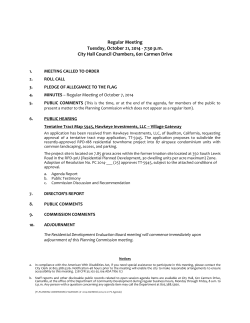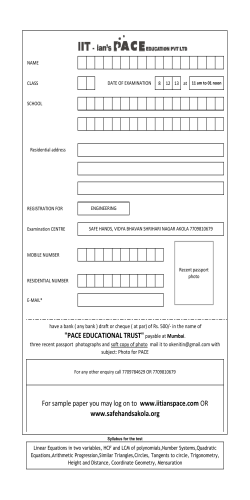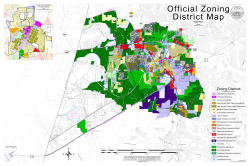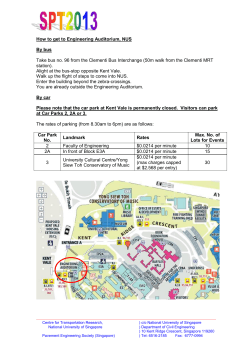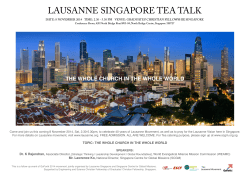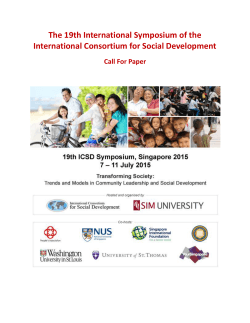
MEDIA RELEASE NEW REGULATIONS TO IMPROVE PRODUCTIVITY IN THE CONSTRUCTION SECTOR
MEDIA RELEASE NEW REGULATIONS TO IMPROVE PRODUCTIVITY IN THE CONSTRUCTION SECTOR 6 Nov 2014 – To further raise construction productivity as outlined in the Budget 2014, the Building and Construction Authority (BCA) announced that the Building Control (Buildability and Productivity) Regulations now include requirements on the use of labour-efficient construction methods and building design. 2. From 1 November 2014, projects are required to: a) Meet higher minimum Buildable Design and Constructability standards. This will make buildings easier to construct and encourage the use of efficient construction methods and processes. b) Use prefabricated and standardised components. All non-landed residential developments are required to adopt drywall as internal partitions for dry areas. In addition, standardised floor heights and building components such as precast staircases, precast refuse chutes and doors will be required for new projects. c) Adopt high-impact productive technologies for projects under the Government Land Sales (GLS) programme. (i) These include the adoption of Prefabricated Bathroom Units (PBUs) in residential (non-landed) sites, including Executive Condominiums, and the residential (non-landed) component of mixed-use sites sold under the GLS programme. (ii) In addition, the adoption of Prefabricated Pre-finished Volumetric Construction (PPVC) will be imposed on selected GLS sites. Please refer to Annex A for more details on the new requirements and Annex B for information on PBUs and PPVC. First two selected GLS sites to adopt PPVC 3. Two upcoming GLS sites at Yishun Avenue 4 and Jurong West Street 41 (scheduled to be released for sale in November and December 2014 respectively) will need to meet these new requirements including the adoption of PPVC. Please refer to Annex C for the location plans of these sites. PPVC involves the assembly of whole rooms or apartment units complete with internal fixtures that are produced off-site and installed on site in a Lego-like manner. 4. Besides these two sale sites, PPVC is being adopted in several projects in Singapore. These include a student hostel at Nanyang Technological University and a building extension to the Crowne Plaza Changi Airport Hotel. City Developments Limited will also be the first developer in Asia to adopt PPVC for a large-scale residential project – an Executive Condominium at Canberra Drive. Extension of tender period for land parcel at Upper Serangoon Road 5. The first sale site that is required to meet the new requirements specified in paragraphs 2(a), 2(b) and 2(c)(i) is the land parcel at Upper Serangoon Road. The tender for the land parcel was launched on 25 September 2014. 6. To provide more time for prospective tenderers to take these new requirements into consideration before submitting their bids, the Urban Redevelopment Authority (URA) is extending the tender closing date for the land parcel at Upper Serangoon Road. The tender will now close on 27 November 2014 instead of 13 November 2014. 7. Information on the land parcel and its location plan are available in Annex D. More details on the land parcel are available at http://www.ura.gov.sg/uol/land-salesrepository/Sites/uppserangoon-cl.aspx. FACTSHEET Annex A A) Higher minimum Buildable Design and Constructability standards The minimum Buildable Design Scores (B-Score) and Constructability Scores (CScores) for all new building projects with GFA of 2,000m2 and 5000m2 respectively, which are submitted for planning permission from 1 November 2014 will be raised by 7 points and 4 points respectively. For projects on land sold under GLS/Industrial GLS Programme and all public sector projects, their B-Scores and C-Scores will be raised by 2 points above the higher BScores and C-Scores set in September 2013. *B-Scores measure the extent to which the design of a building results in less labour to construct while C-Scores are based on the extent to which the adoption of construction techniques and processes are labour efficient. B) Use of prefabricated and standardised components (a) Mandatory items. To raise the adoption of key productivity components, the following components will be mandatory: Types of development Residential (non-landed) developments and residential non-landed component of mixed-used developments Office developments All developments Mandatory items to adopt Dry partition wall for all internal dry areas (exclude party wall, toilet and kitchen) Standardised floor heights Standardised structural openings for doors Standard precast refuse chutes Standardised floor heights Standardised prefabricated staircases (b) Demerit Points for the use of Brickwall. To discourage non-productive method of construction, demerit points will be given for the use of brickwall. C) Adoption of high-impact productive technologies for projects under the Government Land Sales (GLS) programme As developers play a key role in driving productivity improvement, downstream construction work will benefit if building designs include high impact productive technologies at the onset. The following technologies will be stipulated as land sales conditions for developments sold under the GLS Programme from 1 November 2014: (a) Prefabricated Bathroom Units (PBUs). For all residential (non-landed) and residential non-landed component of mixed-use developments on GLS sites, the minimum number of PBUs to be adopted shall be at least 65% of the total number of bathroom units. The PBU systems adopted are required to meet all the performance requirements. For more information, please visit: http://www.bca.gov.sg/BuildableDesign/pbu.html (b) Prefabricated Prefinished Volumetric Construction (PPVC). For selected sites under the GLS Programme, developers will be required to adopt a minimum level of PPVC which shall be at least 65% of the total constructed floor area of the building to be used for residential or private dwelling purposes. This includes all floors except the basement and any floor area constructed for use as a roof or car park. Annex B PREFABRICATED PRE-FINISHED VOLUMETRIC CONSTRUCTION (PPVC) In Prefabricated Pre-finished Volumetric Construction (PPVC), complete flats or modules made of multiple units complete with internal finishes, fixtures and fittings are manufactured in factories, and are then transported to site for installation in a Lego-like manner. PPVC can be considered for residential and mixed (residential and commercial) developments, institutional and other projects as well as other accommodation type of developments such as hotels, hostels and nursing homes. Assembly of PPVC modules on site Benefits of PPVC • • • PPVC can help to significantly speed up construction. It can potentially achieve a productivity improvement of up to 50% in terms of manpower and time savings, depending on the complexity of the projects. Furthermore, dust and noise pollution can be minimised as more activities are done off-site. With the bulk of the installation activities and manpower moved off-site to a factory controlled environment, site safety will also improve. PPVC in Singapore In terms of regulatory clearance, PPVC has already obtained In-Principle Acceptance from all the technical agencies for use in Singapore. There are currently five suppliers (Swee Hong / Unitised Building Australia, Moderna Homes, Sembcorp EOSM, Unitised Building Australia / UB RUSH and Teambuild) for PPVC in Singapore. • • • Nanyang Technological University had awarded the tender to construct their upcoming student hostel project using PPVC to Singapore Piling & Civil Engineering Pte Ltd (part of BBR Holdings (S) Ltd). Separately, OUE has awarded the tender to develop the extension of the Crowne Plaza Hotel at Changi Airport to Dragages Singapore Pte Ltd. Dragages will be working with Unitised Building who will be prefabricating the modules for the Crowne Plaza extension in their Shanghai factory before they are shipped to Singapore for installation next year. CDL will be the first developer in Asia to adopt PPVC for an unprecedented, large-scale residential project - an Executive Condominium (EC) at Canberra Drive. The development which comprises eight 10 to 12-storey blocks with an estimated 636 apartments will be constructed using some 3,300 building modules - likely the largest application of PPVC in the world OUE Crowne Plaza Hotel Extension CDL’s Executive Condominium (EC) at Canberra Drive NTU North Hill Hostel PREFABRICATED BATHROOM UNIT (PBU) The construction of conventional bathrooms requires numerous workers to do more than 13 trades on site. These include waterproofing and tiling as well as sanitary, plumbing and electrical works. On the other hand, Prefabricated Bathroom Units (PBUs) are pre-assembled in factories before they are delivered to site for installation. This enables the construction of the entire bathroom to be streamlined and done efficiently in the controlled environment of the factory, minimising the disturbance to surrounding residents as well as ensuring higher quality finishing. PBUs can bring about manpower and time savings of about 60%, depending on the design and materials used. This is not a new technology and has been used in Singapore in the last ten years or more. PBU designs have also evolved and improved tremendously both in Singapore and overseas as innovative materials and more advanced technologies create possibilities for PBUs to be of better quality and yet not compromised by challenges in handling and transportation. One example is the evolvement of volumetric concrete PBU to lightweight concrete PBU. Ensuring PBUs meet minimum standards As BCA is mandating the use of PBUs for non-landed residential GLS sites, it will be critical to ensure that the different PBU systems coming into the market are reliable and durable systems which will not result in future maintenance problems for the home owners. PBU suppliers are required to apply and go through the Building Innovation Panel (BIP), which consists of both BCA as well as other relevant authorities/agencies. Firstly, a PBU Screening Panel chaired by BCA and other industry representatives will look into the PBU system’s design and materials used. The main objective of the panel is to ensure that each PBU system is both flexible and robust enough in terms of their design, to cater to both developers and home owners’ needs. In addition, the materials used should be both safe and durable as well. Next, the other agencies on the BIP would also look into areas under their jurisdiction, e.g. SCDF will be focusing on fire safety-related issues. One-stop Building Innovation Panel (BIP) New construction technologies or methods often take a longer time to obtain approvals by the various regulatory agencies. Such a process might deter potential innovative products or methods which help to boost construction productivity to be introduced in Singapore. In May 2011, the inter-agency BIP was established to facilitate expedient multiple agency evaluation and approval of innovative construction products and methods that help improve construction productivity by at least 20%. Led by MND and BCA, the panel includes other agencies such as HDB, JTC, NEA, LTA, URA, SCDF, PUB and MOM. For applications that have been approved by the Panel, the regulatory agencies issue an in-principle acceptance (IPA) letter for the innovative product or method. For subsequent project submission involving the products or methods issued with IPA, the submission will be accorded fast-track status. Through the BIP, new productive technologies such as PPVC and CLT can now be used in Singapore. Annex C Yishun Avenue 4 Jurong West Street 41 Annex D Information on Land Parcel at Upper Serangoon Road Location Upper Serangoon Road Site Area (1) 10,097.2 m2 Land Use Zoning Residential with commercial at 1st storey Maximum Gross Floor Area (GFA) 30,292 m2 * Maximum Building Height Part 3-storey, part 5-storey and part 64 m AMSL(2) Estimated Number of Housing Units (3) 340 Lease Period 99 years (1) (2) (3) (*) Site area subject to cadastral survey AMSL means Above Mean Sea Level Actual number of dwelling units provided by the developer may vary The maximum permissible commercial GFA is 2,500 m2
© Copyright 2025

